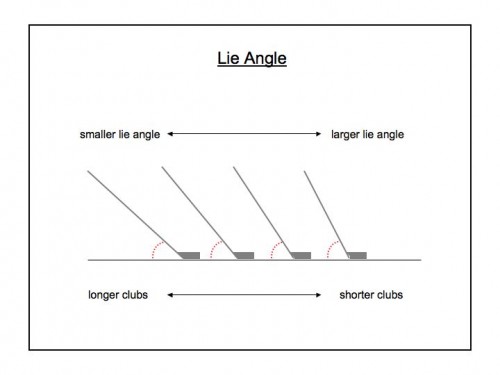Now that you understand the basics of iron design (cast vs. forged, muscle-back vs. cavity-back, player’s club vs. game-improvement club), let’s talk about getting the right fit. When it comes to irons, you’ll need to consider the following:
1. Lie angle.
The lie angle of an iron is the angle made between the ground and the club shaft when the sole of the club rests flat on the ground (as if you were addressing the ball). When this angle is smaller, the lie angle is said to be “flatter.” When this angle is larger, the lie angle is said to be “more upright” (see diagram below). Longer clubs are flatter, shorter clubs are more upright.
Every set of irons will have a standard lie angle for each iron in the set. For example, the Mizuno MX-200 6-iron has a standard lie angle of 61 degrees, the 5-iron is 60.5, and the 4-iron is 60. Depending on your height and swing, however, you may need to have the lie angle adjusted. Getting the lie angle right is crucial to making solid contact and hitting the ball straight. If the lie angle is too flat for your swing, you will get toe-heavy divots and your shots will tend to fly right of the target. If the lie angle is too upright for your swing, you will get heel-heavy divots, the ball will make impact too low on the face, and your shots will tend to fly left of the target.
The easiest way to determine the proper lie angle for your swing is to take a few swings with lie tape and and a lie board. Lie tape is a strip of tape that sticks to the sole of the club. When you hit a ball off of a plastic lie board, the tape will scuff. If after hitting a few balls the scuff mark is consistely in the middle of the strip, the lie angle properly matches your swing. If the scuff mark is consistently towards the heel, the club is too upright and needs to be bent flatter. If the scuff mark is consistently towards the toe, the club is too flat for your swing and needs to be bent more upright. Most retail stores will do a lie angle fitting at no extra cost, and they can generally make any adjustments in the store (though some cast irons would need to be adjusted in the factory). Typical adjustments range from .5 degrees to 2 degrees either way (flatter or more upright) for every iron in the bag. If someone recommends an adjustment of greater than 2 degrees, make absolutely sure that person knows what he/she is talking about before doing anything!
2. Length.
One quick measurement from your wrist down to the ground is all you will need to get the right length on your irons. Most retailers will measure you for length as part of the free fitting process. While most golfers are fine with standard-length irons, some shorter or taller players will be better served by quarter to half-inch adjustments in length. If you need your irons shortened, the retailer can most likely do this for you in the store. If you need them lengthened, you’ll probably have to special order longer clubs from the factory.
3. Shaft flex.
Look here for information on shaft flex. In our post on the driver, we talked about the importance of getting the proper flex in the club shaft. It’s equally important for your irons. Mizuno has developed technology called the “Shaft Optimizer” that can give you your proper iron shaft fitting after just three swings of the club. The Shaft Optimizer is a device that attaches to the shaft of the club. When the club is swung, the device takes readings of the motion and speed of the club through impact. The data gathered from a few swings is then used to generate a recommended shaft type and flex for your swing. Many retailers have the Shaft Optimizer on hand, but if you can’t find one at your local store you may want to visit the Mizuno tent at the nearest club demo day.
4. Grips.
The type of grip you choose is a matter of preference. Most sets of irons come with standard issue grips, but you can always opt to have the clubs regripped after choosing a feel and style that you like. Generally speaking, club regripping can be done on the spot for anywhere between $3 and $10 per club, depending on the type of grip you prefer (that includes labor costs).
You should also consider the size, or thickness, of the grip. The thickness can be increased by first wrapping the end of the club shaft with layers of tape before putting the grip on. A standard grip installation will include one tape wrap, and then you’ll have the option to add additional layers if need be. Adding anywhere from one to four layers of additional tape underneath the grip is pretty standard. A few rules of thumb: (1) the bigger your hands, the thicker you’ll want the grip, and (2) the more you tend to hook the ball, the thicker you’ll want the grip. A grip that is too thin can promote overactive hands through impact, and overactive hands often lead to hooks. These are tendencies, of course, not absolutes.
Alright. You’ve got the information you need to properly upgrade your irons. Whatever you do, make sure you absolutely love them before swiping your card. Knowing and believing you can hit them well is half the battle.
